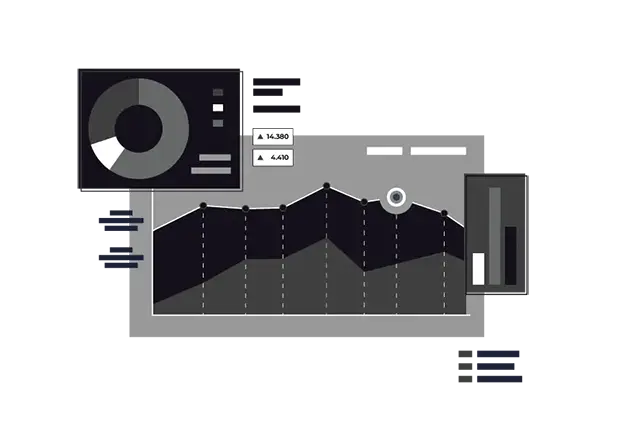

MATLAB
MATLAB (Matrix Laboratory) is a powerful numerical computing environment and programming language developed by MathWorks, widely used for technical computing, data analysis, algorithm development, and scientific research. First released in the late 1970s, MATLAB has evolved into one of the most versatile and robust platforms for engineers, scientists, and analysts to perform complex calculations, visualize data, and develop sophisticated algorithms. With its extensive library of built-in functions, intuitive interface, and cross-disciplinary applicability, MATLAB is a preferred choice in academia, industry, and research institutions worldwide.
MATLAB
MATLAB (Matrix Laboratory) is a powerful numerical computing environment and programming language developed by MathWorks, widely used for technical computing, data analysis, algorithm development, and scientific research. First released in the late 1970s, MATLAB has evolved into one of the most versatile and robust platforms for engineers, scientists, and analysts to perform complex calculations, visualize data, and develop sophisticated algorithms. With its extensive library of built-in functions, intuitive interface, and cross-disciplinary applicability, MATLAB is a preferred choice in academia, industry, and research institutions worldwide.
Mission and Vision
The mission of MATLAB is to provide an integrated environment that empowers users to explore, model, and analyze complex data sets and systems efficiently. MATLAB's vision is to enable innovation and discovery by providing a unified platform that supports technical computing, modeling, and simulation across various industries, from automotive and aerospace to finance and healthcare.
MathWorks, the company behind MATLAB, strives to make its software an essential tool in solving today's scientific and engineering challenges. By continuously expanding MATLAB's capabilities and enhancing user experience, MathWorks aims to advance research, accelerate product development, and improve decision-making through data-driven insights.
Key Features and Capabilities
MATLAB is known for its extensive feature set that supports a wide range of applications. Some of its key features include:
 High-Level Language and Interactive Environment: MATLAB combines a high-level programming language with an interactive environment that facilitates matrix manipulations, data visualization, and algorithm development. Its syntax is designed to be intuitive, making it accessible for users with varying levels of programming expertise.
High-Level Language and Interactive Environment: MATLAB combines a high-level programming language with an interactive environment that facilitates matrix manipulations, data visualization, and algorithm development. Its syntax is designed to be intuitive, making it accessible for users with varying levels of programming expertise. Extensive Mathematical Functions: MATLAB offers an extensive library of mathematical functions for linear algebra, statistical analysis, optimization, numerical integration, signal processing, and more. These functions enable users to perform complex mathematical computations with minimal coding effort.
Extensive Mathematical Functions: MATLAB offers an extensive library of mathematical functions for linear algebra, statistical analysis, optimization, numerical integration, signal processing, and more. These functions enable users to perform complex mathematical computations with minimal coding effort. Advanced Data Visualization Tools: MATLAB provides powerful data visualization tools that allow users to create 2D and 3D plots, graphs, and interactive charts. These visualizations help users explore data, identify trends, and communicate findings effectively. MATLAB's graphics system supports high-quality, publication-ready outputs.
Advanced Data Visualization Tools: MATLAB provides powerful data visualization tools that allow users to create 2D and 3D plots, graphs, and interactive charts. These visualizations help users explore data, identify trends, and communicate findings effectively. MATLAB's graphics system supports high-quality, publication-ready outputs. Toolboxes and Specialized Applications: MATLAB's functionality can be extended through a vast array of toolboxes, which are add-on collections of specialized functions tailored for specific applications. Popular toolboxes include the Image Processing Toolbox, Signal Processing Toolbox, Control System Toolbox, and Machine Learning Toolbox. These toolboxes provide pre-built functions that accelerate development and reduce the need for custom code.
Toolboxes and Specialized Applications: MATLAB's functionality can be extended through a vast array of toolboxes, which are add-on collections of specialized functions tailored for specific applications. Popular toolboxes include the Image Processing Toolbox, Signal Processing Toolbox, Control System Toolbox, and Machine Learning Toolbox. These toolboxes provide pre-built functions that accelerate development and reduce the need for custom code. Simulink Integration: MATLAB integrates seamlessly with Simulink, a graphical environment for modeling, simulating, and analyzing dynamic systems. Simulink is widely used in control design, system engineering, and real-time testing, making MATLAB ideal for applications that require modeling of complex systems.
Simulink Integration: MATLAB integrates seamlessly with Simulink, a graphical environment for modeling, simulating, and analyzing dynamic systems. Simulink is widely used in control design, system engineering, and real-time testing, making MATLAB ideal for applications that require modeling of complex systems. Algorithm Development and Deployment: MATLAB supports the entire workflow of algorithm development, from prototyping to deployment. Users can test, refine, and optimize algorithms using built-in debugging tools and performance analysis functions. MATLAB's code can be compiled into standalone applications, embedded software, or integrated into other programming languages.
Algorithm Development and Deployment: MATLAB supports the entire workflow of algorithm development, from prototyping to deployment. Users can test, refine, and optimize algorithms using built-in debugging tools and performance analysis functions. MATLAB's code can be compiled into standalone applications, embedded software, or integrated into other programming languages. Machine Learning and Deep Learning Capabilities: MATLAB provides a comprehensive environment for developing machine learning and deep learning models. Its built-in apps and functions allow users to train, validate, and deploy models for tasks such as classification, regression, clustering, and neural network training.
Machine Learning and Deep Learning Capabilities: MATLAB provides a comprehensive environment for developing machine learning and deep learning models. Its built-in apps and functions allow users to train, validate, and deploy models for tasks such as classification, regression, clustering, and neural network training. Integration with Other Languages and Systems: MATLAB supports integration with other programming languages, such as Python, C/C++, Java, and .NET. It also connects with external hardware, databases, and cloud computing platforms, enabling seamless data exchange and interoperability in complex workflows.
Integration with Other Languages and Systems: MATLAB supports integration with other programming languages, such as Python, C/C++, Java, and .NET. It also connects with external hardware, databases, and cloud computing platforms, enabling seamless data exchange and interoperability in complex workflows. MATLAB Online and MATLAB Drive: MATLAB Online allows users to run MATLAB directly in a web browser without the need for software installation. MATLAB Drive provides cloud storage that enables users to access their files and projects from anywhere, enhancing collaboration and mobility.
MATLAB Online and MATLAB Drive: MATLAB Online allows users to run MATLAB directly in a web browser without the need for software installation. MATLAB Drive provides cloud storage that enables users to access their files and projects from anywhere, enhancing collaboration and mobility. Documentation and Community Support: MATLAB offers extensive documentation, tutorials, and examples that help users get started and troubleshoot issues. The MATLAB community, including forums, user groups, and MathWorks File Exchange, provides additional support, code sharing, and collaboration opportunities.
Documentation and Community Support: MATLAB offers extensive documentation, tutorials, and examples that help users get started and troubleshoot issues. The MATLAB community, including forums, user groups, and MathWorks File Exchange, provides additional support, code sharing, and collaboration opportunities.
Applications and Use Cases
MATLAB's versatility makes it suitable for a wide range of applications across various industries:
 Engineering and Robotics: MATLAB is widely used in engineering fields for designing control systems, signal processing, and robotics. Engineers use MATLAB to model and simulate physical systems, design control algorithms, and develop prototypes.
Engineering and Robotics: MATLAB is widely used in engineering fields for designing control systems, signal processing, and robotics. Engineers use MATLAB to model and simulate physical systems, design control algorithms, and develop prototypes. Financial Modeling: In finance, MATLAB is used for risk analysis, algorithmic trading, portfolio optimization, and asset pricing. Its powerful computational tools enable financial analysts to model complex financial systems and develop data-driven strategies.
Financial Modeling: In finance, MATLAB is used for risk analysis, algorithmic trading, portfolio optimization, and asset pricing. Its powerful computational tools enable financial analysts to model complex financial systems and develop data-driven strategies. Medical Imaging and Bioinformatics: MATLAB's image processing capabilities are leveraged in medical imaging for tasks such as image segmentation, enhancement, and pattern recognition. In bioinformatics, MATLAB is used to analyze genomic data, model biological systems, and develop predictive models.
Medical Imaging and Bioinformatics: MATLAB's image processing capabilities are leveraged in medical imaging for tasks such as image segmentation, enhancement, and pattern recognition. In bioinformatics, MATLAB is used to analyze genomic data, model biological systems, and develop predictive models. Data Science and Machine Learning: Data scientists use MATLAB for data preprocessing, feature extraction, and predictive modeling. MATLAB's machine learning toolbox simplifies the process of training and evaluating models, making it a valuable tool for data-driven decision-making.
Data Science and Machine Learning: Data scientists use MATLAB for data preprocessing, feature extraction, and predictive modeling. MATLAB's machine learning toolbox simplifies the process of training and evaluating models, making it a valuable tool for data-driven decision-making. Aerospace and Defense: MATLAB is extensively used in the aerospace and defense sectors for system modeling, flight dynamics analysis, and signal intelligence. Its ability to simulate complex systems helps engineers design and test mission-critical technologies.
Aerospace and Defense: MATLAB is extensively used in the aerospace and defense sectors for system modeling, flight dynamics analysis, and signal intelligence. Its ability to simulate complex systems helps engineers design and test mission-critical technologies. Academic Research and Education: MATLAB is a staple in academia, used in teaching mathematics, engineering, physics, and economics. Its intuitive interface and extensive resources make it a valuable tool for student learning and faculty research.
Academic Research and Education: MATLAB is a staple in academia, used in teaching mathematics, engineering, physics, and economics. Its intuitive interface and extensive resources make it a valuable tool for student learning and faculty research. Automotive Industry: MATLAB supports the automotive industry in areas such as engine modeling, vehicle dynamics, and autonomous driving. Engineers use MATLAB to develop simulations, test algorithms, and validate systems under various scenarios.
Automotive Industry: MATLAB supports the automotive industry in areas such as engine modeling, vehicle dynamics, and autonomous driving. Engineers use MATLAB to develop simulations, test algorithms, and validate systems under various scenarios.
Benefits of Using MATLAB
MATLAB offers numerous benefits that enhance the research, development, and decision-making processes:
 Ease of Use: MATLAB's intuitive interface and high-level syntax make it accessible to both novice and experienced users. The environment simplifies complex tasks, allowing users to focus on problem-solving rather than coding.
Ease of Use: MATLAB's intuitive interface and high-level syntax make it accessible to both novice and experienced users. The environment simplifies complex tasks, allowing users to focus on problem-solving rather than coding. Rapid Prototyping and Development: MATLAB's extensive library of functions and toolboxes accelerates the development of algorithms and models, reducing the time required to move from concept to implementation.
Rapid Prototyping and Development: MATLAB's extensive library of functions and toolboxes accelerates the development of algorithms and models, reducing the time required to move from concept to implementation. Scalability and Performance: MATLAB can handle large-scale computations and is optimized for performance, making it suitable for both small-scale analyses and enterprise-level applications.
Scalability and Performance: MATLAB can handle large-scale computations and is optimized for performance, making it suitable for both small-scale analyses and enterprise-level applications. Comprehensive Visualization Tools: MATLAB's advanced graphics capabilities allow users to visualize data in multiple formats, making complex results easier to interpret and communicate.
Comprehensive Visualization Tools: MATLAB's advanced graphics capabilities allow users to visualize data in multiple formats, making complex results easier to interpret and communicate. Interdisciplinary Collaboration: MATLAB's integration with other programming languages and platforms facilitates collaboration among multidisciplinary teams, enabling seamless workflows across different fields.
Interdisciplinary Collaboration: MATLAB's integration with other programming languages and platforms facilitates collaboration among multidisciplinary teams, enabling seamless workflows across different fields. Extensive Support and Resources: MATLAB's robust support system, including comprehensive documentation, community forums, and training materials, provides users with the tools they need to troubleshoot problems and enhance their skills.
Extensive Support and Resources: MATLAB's robust support system, including comprehensive documentation, community forums, and training materials, provides users with the tools they need to troubleshoot problems and enhance their skills. Long-Term Industry Relevance: MATLAB's continuous development and updates ensure that it remains relevant and capable of meeting the evolving needs of industries and research fields.
Long-Term Industry Relevance: MATLAB's continuous development and updates ensure that it remains relevant and capable of meeting the evolving needs of industries and research fields.
Promoting Collaboration and Knowledge Sharing
MATLAB encourages collaboration through features that support teamwork, data sharing, and co-development. MATLAB Drive and MATLAB Online allow researchers and developers to work together in real time, regardless of location. MATLAB's integration capabilities also enable different departments and industries to connect their workflows, facilitating the exchange of ideas and innovations. MathWorks also promotes knowledge sharing through events, conferences, and competitions, such as MATLAB EXPO and MathWorks Challenges, which bring together users to showcase their projects, share insights, and learn from industry experts.
Impact on Research, Industry, and Education
MATLAB's impact extends across research, industry, and education, driving advancements in technology, improving efficiency, and enhancing learning:
 Research Advancements: MATLAB has been instrumental in numerous scientific discoveries and technological innovations, enabling researchers to model complex systems, analyze vast datasets, and develop new algorithms.
Research Advancements: MATLAB has been instrumental in numerous scientific discoveries and technological innovations, enabling researchers to model complex systems, analyze vast datasets, and develop new algorithms. Industrial Efficiency: In industry, MATLAB helps organizations optimize processes, reduce costs, and bring products to market faster. Its simulation capabilities allow companies to test and refine designs before physical prototypes are built.
Industrial Efficiency: In industry, MATLAB helps organizations optimize processes, reduce costs, and bring products to market faster. Its simulation capabilities allow companies to test and refine designs before physical prototypes are built. Educational Transformation: MATLAB's role in education empowers students with practical skills in data analysis, programming, and problem-solving, preparing them for careers in STEM fields. It provides educators with powerful tools to illustrate complex concepts and engage students in interactive learning.
Educational Transformation: MATLAB's role in education empowers students with practical skills in data analysis, programming, and problem-solving, preparing them for careers in STEM fields. It provides educators with powerful tools to illustrate complex concepts and engage students in interactive learning.
Conclusion
MATLAB stands as a cornerstone of numerical computing and technical innovation, providing a comprehensive environment that supports research, development, and education across diverse fields. Its extensive capabilities, user-friendly interface, and robust support system make it an indispensable tool for scientists, engineers, and analysts worldwide. By enabling the exploration of complex data, the modeling of dynamic systems, and the development of cutting-edge technologies, MATLAB continues to advance the frontiers of science and engineering, making a lasting impact on society.
Resource Library
Partnered Content Networks
© 2024 STEM Network. All rights reserved.





























